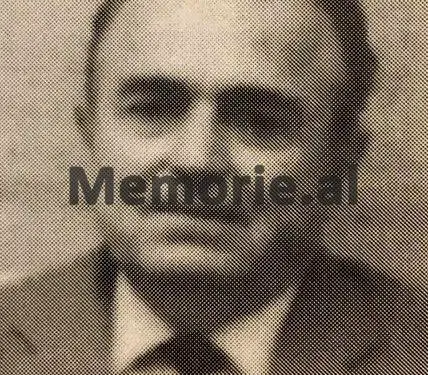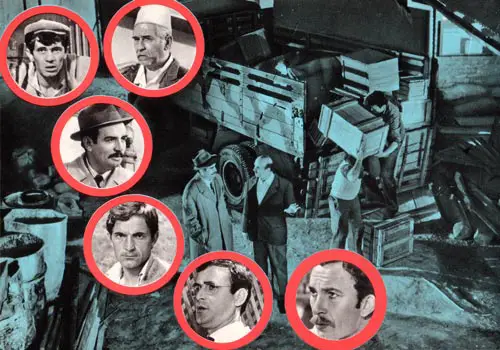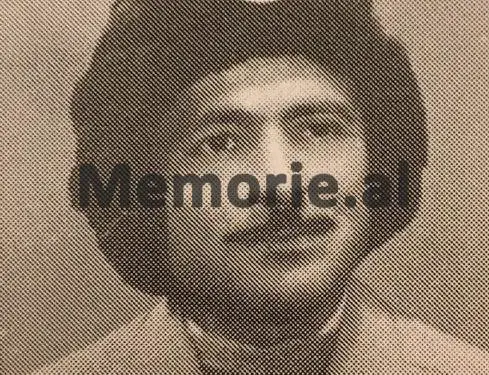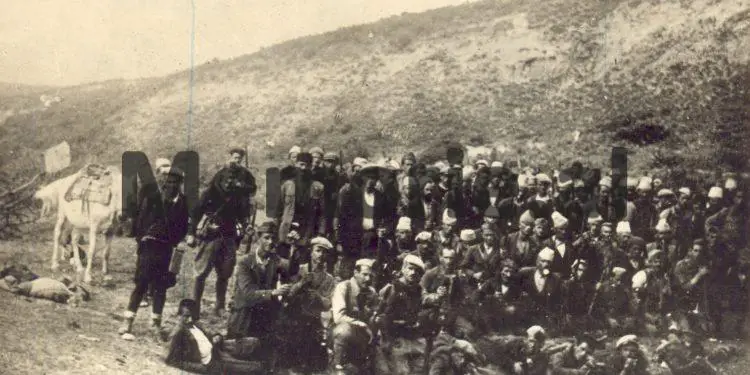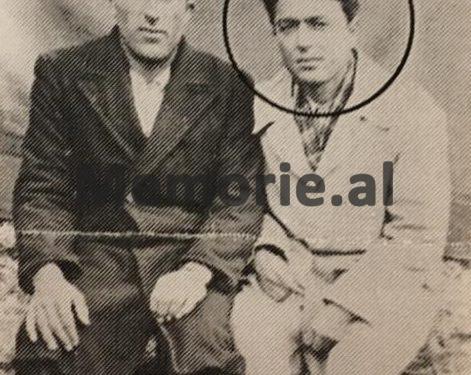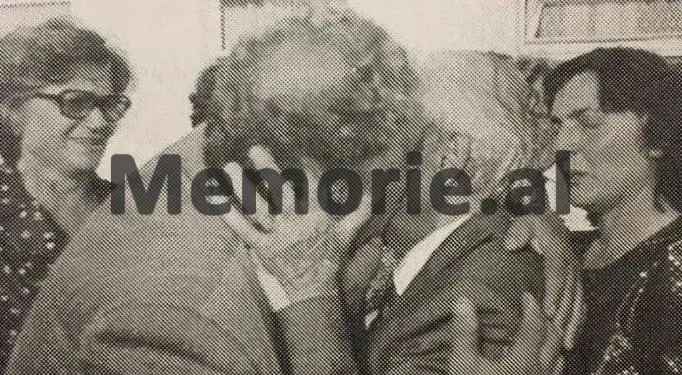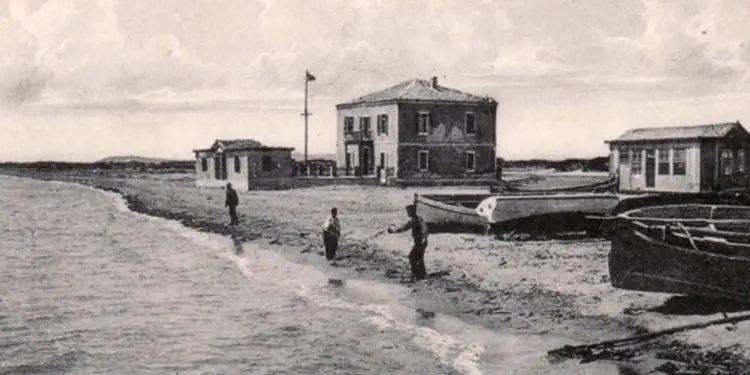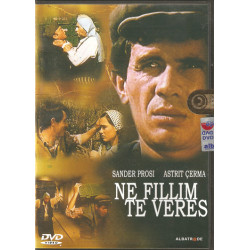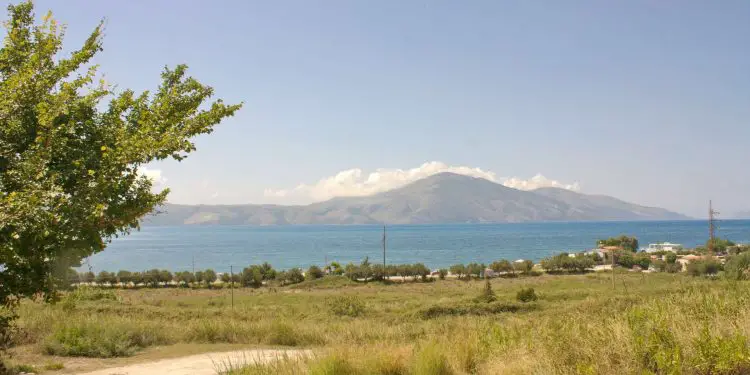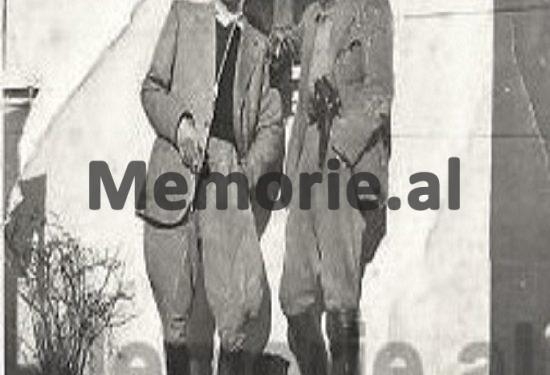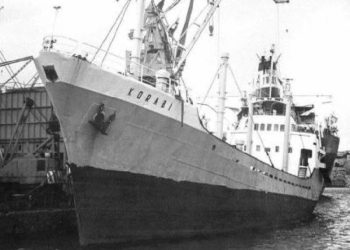Dashnor Kaloçi
Memorie.al publishes the unknown story of the action that took place in August 1941 where the ammunition depots that the Italians had concentrated in the village of Rradhimë of Vlora were blown up, which were guarded by the “Siena” Division, an action for which at the end of In the 70’s, the communist regime dedicated the feature film of Kinostudio “Shqipëria e Re”, entitled “In the beginning of summer”. The rare testimony of Jaup Xhezo Iljazi, originally from the village of Tragjas in Vlora, who, at the suggestion of Hysni Lepenica, Mehmet Alemi, Skënder Muço and Hysni Kapos, took over and carried out the action of blowing up those large ammunition depots that the Italians used during the Italo-Greek war. The truth of that event which the historiography and propaganda of the communist regime attributed to the “People’s Hero”, Shyqëri Alimerko, dedicating to him the feature film in the late ’70s, as well as the tragic fate of the real author of that event, that after being interned by the Germans in the extermination camps in Austria, he was imprisoned by the communists as soon as he returned to Albania, being accused of being an “agent of the Germans and the British” ?! His escape from Albania after his release from prison in 1952, joining the “Company 4000” in Germany and then emigrating to the US, where he stayed until 1998, when he returned permanently to Albania, to spend the days of last of life in his hometown of Vlora.
“At the beginning of August 1941, Hysni Lepenica, Skënder Muço, Mehmet Alemi and Hysni Kapo, who were also the main leaders of the Anti-Fascist Movement of Vlora at that time, came to my house in Izvor, Vlora, and together we discussed at length about the throw in the wind of ammunition depots that the Italians had concentrated in the village of Rradhimë. I undertook the execution of that action and together with me it was decided that Selim Laçej would also come, and after a week and two together, after we took with us a can of gasoline, gunpowder and some ashes, at two o’clock in the morning we arrived to the depots where there were about 20 trunks with tens of tons of well-stacked ammunition. After we captured one of the 14 Italian guards …”This is how Jaup Xhezo Iljazi, a former student of the Vlora Business School and the Faculty of Economics in Bologna, Italy, who was one of the Hysni Kapos’s closest comrades and collaborators, from where they parted ways in September 1943, following the break-up of the Mukje Agreement, when the brother-killing between the communists and nationalists of the National Front of Legality began. Imprisoned by the Germans in the mass extermination camps in Austria and later by the communists, who had fled Albania since 1952, Jaup Xhezo Iljazi returned to Albania to spend the last days of his life in his suburban home. Of the neighborhood “Skelë”, from where he left 46 years ago. With a reminder to be envied, in the meeting we had with him, he told us in detail and details about one of the most sensational events of the war period that of blowing up ammunition depots located in Rradhima of Vlora. An event which was perpetuated by the communist regime with the film “In the beginning of summer”, produced by Kinostudio “Shqipëria e re”, but attributing that action to Shyqëri Alimerkos (“People’s Hero”). Regarding this and other events from his life, we know the interviews we had with Jaup Xhezo Iljazi, shortly before he passed away, where his son-in-law, Fahri Shaska, the man who knew us from first, with the true story of the Rradhima warehouse action, which was kept secret and was not made public even after the fall of the communist regime.
Mr. Jaup, what activity did you have during the period when you were a student at the Commercial School of Vlora?
During those eight years that I was a student at the Commercial School of Vlora, I did not have any activity worth mentioning, but together with my close friend Hysni Kapo, we talked and talked with our school friends and the city against fascism. Hysni Kapo and I increased our anti-fascist beliefs even more during 1940, when we went to study in Italy.
What did you study for in Italy?
After graduating with good grades from the Commercial School of Vlora, together with Hysni Kapo we won a right to study at the Faculty of Economics of the University of Bologna in Italy. In that faculty I continued only the first year, because in April 1941, I returned to Albania with the sole purpose of fighting against the Italian fascists who had invaded our homeland.
Did Hysni Kapo return?
Hysni Kapo stayed only a short time in Bologna and he returned before starting his studies. As soon as he arrived in Vlora, he started working as a secretary in the city hospital and immediately joined the Antifascist Resistance.
When you returned to Vlora, with whom did you establish connections in your anti-fascist activity?
As soon as I came to Vlora, I contacted the well-known lawyer Skënder Muço, whom I also had a cousin. Through Skënder I also connected with other exponents of the Anti-Fascist Movement, such as: Hysni Lepenica, Mehmet Alemi, etc. and together with them we discussed how to start concrete actions against the Italian invaders.
When did you start these actions?
The first action we carried out was that of blowing up the ammunition depots that the Italians had gathered and concentrated in the village of Radhimë in Vlora. From this giant depot, which consisted of more than 20 silos built in the form of barracks and other piles of shells and ammunition covered with raincoats, was supplied the entire Italian army which was fighting on the front with Greece.
What is the truth about the action of burning those warehouses, for which before the ’90s, the feature film “In the beginning of summer” was dedicated to that event?
I remember that action very well, not only because it was the first action I took part in, but also because I was injured in the hand. That action was carried out in the village of Rradhimë of Vlora, where the Italians at that time had collected and concentrated large quantities of ammunition. From that giant depot, which consisted of more than 20 silos built in the form of barangas and other piles of shells and ammunition covered with raincoats, supplied the entire Italian army, which was fighting on the front with Greece.
Who decided to carry out that action?
At the beginning of August 1941, Hysni Lepenica, Skënder Muço, Mehmet Alemi and Hysni Kapo, who were also the main leaders of the Anti-Fascist Movement of Vlora at that time, came to my house in Izvor, Vlora. After much discussion, it was decided to attack that ammunition depot, burning it and blowing it up. I undertook to carry out that action and it was decided that Selim Laçej would come with me.
How did you manage to perform that action?
A few days after that meeting that took place in my house, seeing also the time that was rainy and quite suitable for carrying out the action, sometime around 2 o’clock at night, I left the house jumping out the window. I did that because the door of the house was only locked from the inside and I did not want to wake the people of the house, as they not only should not have known anything about that action, but could also prevent me from going out at that hour late outside the home. This is also due to the fact that the Command of the Italian Division “Siena” was located very close to our house, which was guarded with soldiers day and night.
But why was your family unaware of your involvement in the Antifascist Movement?
The family knew something, that is, that I was engaged in the Antifascist Movement, but for concrete things such as the action in question that we would carry out, it was not even mentioned. These things were in great conspiracy and no one should have known.
What did you do when you left the house?
As soon as I left the house without feeling anyone, I went to the appointed place and met Selimi. After staying there for a while to make sure no one had spotted us, we headed to the village of Rradhimë, where the ammunition depots were located, which lay over a large area. The entire complex of those depots was guarded by 14 well-armed Italian guards, who were stationed across the heights and key points of those surrounding mountains and hills. Due to the fact that the guards were located at a distance from each other, they could not control the place by patrolling, but had a signal, calling each other by numbers, according to the place of guard where they were. After eavesdropping for a while to see how those depots were guarded, we approached the 14th guard, whom Selimi put his rifle in his throat. He offered no resistance and we disarmed him, threatening to kill him if he moved. The Italian guard remembering that we would be too many in that action made no move and when it came time to repeat the signal, called the number 14. After that I got inside the barbed wire with which the whole territory of i was surrounded. Depots and approached one of the stacks of cannonballs that was covered with raincoats and was located in front of the barracks. After preparing the gunpowder and spraying the place with the can of gasoline I had taken with me, I turned on the ashtray and immediately left quickly for the place where I had entered.
How long did the burning of the ashes that would ignite the gunpowder continue?
The burning of the ashes lasted no more than five minutes and while I was passing the barbed wire fence, the first explosion was heard. At that time, out of fear, I ran away from my eyes, walking on thorns and stones, tearing at all parts of my body. While I was running, I heard the second explosion, and so on, the other explosions, as the stacks lit up each other. At that moment the flame of smoke coming out of them, raised high in the sky making the place light. Selimi and I continued to run up the mountain, without turning our heads back and stopped running at the place called Izvor Squares, at the top of Llustra. There we parted and Selimi fled to his village, Tragjas, while I returned to my home.
How long did the explosions last in those warehouses and what happened next?
The blasts continued for 24 hours without interruption, while the flames and smoke continued even longer. From the moment when the first explosions were heard there, an alarm was given and the forces of the “Siena” Division gathered nearby, as well as numerous other reinforcements that came from the city of Vlora. All those forces that gathered there, just watched the flames, as they had no chance of escaping anything from those who were there.
When you got home did you tell people about the action you had taken?
As I approached the house, I pulled out a white handkerchief and shook it so that I would not be shot by the Italian guards guarding the Siena Division Command, which was very close to our lands. After the explosion, the people in my house woke up and by not seeing me inside; they thought I would have done it. After that, my brother secretly left the house and after taking does it have, came to me in order to justify my entry into the house at that late hour of the night. When we entered, my father and mother hugged me thankfully I was alive and then immediately brought me my clothes to be changed, as the ones I was wearing were torn to pieces. In the morning I left the house quite calm and to create an alibi, I immediately went to the municipal offices in the village of Dukat, where its mayor, Mustafa Matohiti was drinking beer with Mehmet Alemi.
Did you later meet those who charged you with carrying out the action?
After a week, they came to Tragjas; Hysni Lepenica, Skënder Muço and Hysni Kapo, who congratulated me for the action I had done. During that conversation with them, Hysni Kapo told me: “Congratulations Jaup, your action has caused a great commotion and I have informed Sinan Gjoni and other friends who are in Tirana prison about this work.”Everyone knows that you carried out this action.”
Did the Italians learn that you were the author of that action?
The Italians should have known who the perpetrators of that action were, because at that time that thing was learned by many people in Vlora. Two or three weeks after the day the landfills were burned, Hamit Musa and I and four other friends went there to take some pictures of the burned waste, which we wanted to have as a document for the action we had taken. . At that time there came three motorcycles with bersalier, who called me to stop. I remembered that I had been dictated to, and for fear of being caught, I threw the only bomb I had at my disposal and ran away. They shot me with a machine gun and a bullet of theirs caught me here in my right hand, where as you can see I still have a mark. As soon as I was able to leave, I immediately went to Hamit Musa’s house, where the old nurse from Dukati, Osman Xhemali, came every day and treated my hand, removing the pieces of lead that had been scattered there. He did not have enough tools to treat me and cut my flesh with scissors. And from this thing even to this day I have this hand crippled. During the time I was being treated at Hamit Musa’s house, Hysni Kapo came to see me, who told me that the whole of Vlora had found out that I had burned the Rradhima warehouses.
Until when did you continue to keep in touch and meet Hysni Kapo?
I met with Hysni Kapo even after that period of time when between the nationalist organization Ballit Kombëtar where I was part of and the Communist Party, where he was one of its main leaders, sharp contradictions and irritations had begun. At that time Hysniu sent me a letter through Selfo Dalani, asking me to meet. Although my friends instructed me not to go to the meeting, as they were afraid that he would take me hostage, I went to the meeting, which we held in Lustra’s neck. With me at that meeting was a colonel of the British missions, named Smith, with whom I had carried out the action of burning the German depots at the “House of the Bey”, where today the “Flag Square” is. While I was giving Smith some information about the location of the German forces he asked me for, Hysni Kapo told me: “Do not give it to them, because we give it to them and we take some reward in clothes or food for the partisans”. During that conversation, when Hysniu called me to go with the communists, I told him: ‘Not only will I not come with you, but I have a message from Skënder Muço to tell you to come to us, because your country is open to Balli”.
What was the response of Hysni Kapos after the invitation you made to come to Balli Kombëtar?
Hysni replied: “I do not intend to come with you to Balli, as we will win the war.” I replied: ‘Hysni, is it difficult for this Englishman to become a communist’?! After that he told me: “If we win the war, we will not need them anymore.” So we parted ways with Hysni Kapo and this was the last meeting we had together during the war, because then I was arrested by the Germans and ended up in extermination camps in Austria.
When did you learn for the first time that an artistic film had been made in Albania, where the main event was that of your action in Rradhimë of Vlora?
I learned that only in 1991, when I first came to Albania and my family people told me about that movie, where the action of burning the Rradhima warehouses that I had done in 1941, and the communist regime had attributed to Shyqëri Alimerkos. Also, my relatives told me that several books had been written about that event, where Shyqëria emerged as the author and hero of that event.
Were you upset by what you learned?
Not only was I not indignant, but I was not surprised at all. I also never asked for it to be written that I did that action with my friend, Selim Laçej, whom the communists had killed since 1944, although he had not been involved in any political activity at all.
Yes Shyqëri Alimerkon, did you know him during the War?
Not only did I know him, but I also attended his funeral, as he was killed during an ambush where he had gone out with some other friends to assassinate Sadik on Friday.
Did Shyqëri Alimerko have any connection with the action of burning the warehouses in Rradhimë of Vlora?
Shyqëriu had no connection or knowledge of that action, and if I am not mistaken at the time he was only 17 years old.
Jaup Xhezo Iljazi, imprisoned by Germans and communists, returned to Albania after 46 years
Jaup Xhezo Iljazi was born on March 13, 1918 in the village of Tragjas in the district of Vlora, where his family comes from. In 1940, he graduated from the Commercial Institute of Vlora and together with his school friend, Hysni Kapon, gained a right to study to attend the Faculty of Economics at the University of Bologna in Italy. After graduating from the first year of that faculty, in 1941, Jaupi returned to Albania and connected with the well-known lawyer and nationalist, Skënder Muço, who at that time was leading the anti-fascist resistance groups in Vlora. At the beginning of August 1944, while returning from the Duchy of Vlora, where he had gone with Skënder Muço to receive a letter sent to them by the Allied Command of the Mediterranean, he was arrested by the Germans. The letter from the British, which was found in his pocket, became the reason for Skënder’s shooting and his deportation to the Rodium extermination camp in Austria. Jaupi was only released from that camp in April 1945, when Red Army forces entered, and on his return to Albania, he was arrested by Serb communists in Subotica, Yugoslavia, and held for some time in Zemun prison. . He was later deported to Albania, where a military trial in the city of Elbasan sentenced him to 101 years in prison, accusing him of being an “agent of the Germans and the British.” He was released from political prison in 1949, when the so-called Koci Xoxa group was attacked. Later, with the intervention of his former close friend, Hysni Kapo, Jaupi was employed as an economist and a simple worker in Vlora and Elbasan. In 1952, when the State Security disappeared his brother without a trace, Jaupi fled Albania and fled to Yugoslavia. During his short stay in Yugoslavia as a political asylum seeker, Jaupi did not accept Dusan Mugosha’s proposal to cooperate with the “TANEF” organization which was fighting to overthrow the communist regime of Enver Hoxha in Albania. Also in 1952, Jaupi immigrated to West Germany, where he stayed for two years in the “Company 4000”, near the town of Karzeslatuten, where at that time were gathered thousands of anti-communist immigrants from various Eastern European countries, who were trained to land. With missions in their countries. After the abolition of that camp in 1954, he stayed for a while in France and then immigrated to the USA, where for several years he became involved in the political life of the Albanian diaspora living on that continent. In 1998, Jaupi left the United States and returned to spend his old age in his hometown of Vlora. From that time until 2003 when he passed away, he continued to write the memories of his long life and with endless vicissitudes./Memorie.al




